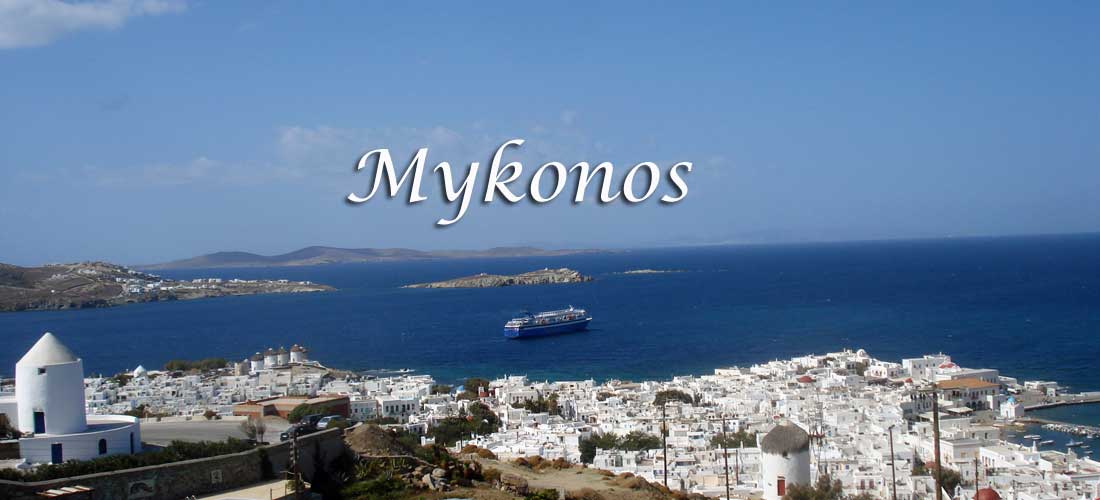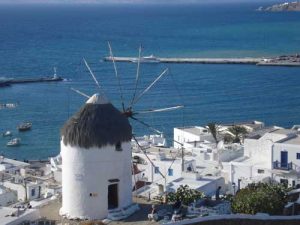Mykonos island Greece
Mykonos the star of the Greek summer and one of the top destinations in the Mediterranean, remains a mythical island that you either fall in love with, or hate. Mykonos lies at the heart of the central Cyclades islands and was once a byword for trendy and chic holidays.
Some have dubbed Mykonos the archetypal Greek island, a treeless granite rock dotted with sugar cube houses and blue-domed churches and all bathed in a dazzling light.
Mykonos is certainly an island of extremes; a playground for the rich and a hangout for young gays who parade nightly through the main town or strike stark poses on the island’s nudist beaches.
But Mykonos has softened over the years. Families have lately reclaimed the beaches and young couples now both marry and spend their honeymoon here. Several Mykonos-based wedding agencies now offer luxury wedding glitz in a dream Greek island setting.
Visitor accommodation options run the whole range, from five star hotel luxury hotels and mega-cruise ship visitors to independent backpackers on budget holiday trek breaks.
The glamour and glitter may have faded, but the “Mykonos magic” still sparkles and the rich and famous can still be seen here on the succession of sandy beaches that run along the south coast.
Mykonos is still the place to see and be seen amid some of the most attractive scenery to be found anywhere in the Greek islands.
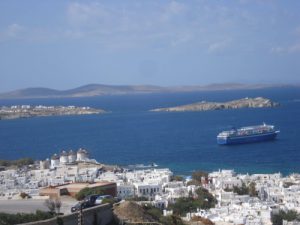
Hotels of every style, award-winning restaurants (with up-and-coming chefs creatively revisiting the Greek tradition), cozy ethnic hangouts, and loud beach clubs cater to different tastes. The same goes for the beaches: from the reserve sunbeds in cosmopolitan Psarou beach and the multi-ethnic evening parties in Super Paradise to the sophisticated Agrari and the off-Broadway secluded Fokos.
After all, Mykonos can accommodate everyone, from the shopping freaks who spend the day and night in Matogiannis street, the tourists who make appointments for sunset in Little Venice and the fashionistas who are looking for the next big event of summer in the new hangouts, to the good old cultured ones who enjoying the concerts with full moon in the magical archeological site of Delos and the sophisicated ones who turn their backs on the crowded alleys of Chora and choose Ano Mera for their outings.
At some point Mykonos gets to know Tourism, when the first visitors passing by to go to Delos, discover the island. The first phase of the tourist development of Mykonos during 1930-1970, was based on the authentic Cycladic landscape.
The environment, the architecture and on the character of the inhabitants, hospitable, tolerant, friendly and open, which constituted the identity of the island.
The second phase, 1980 to present, was based on the modern fairy tale of lifestyle. Mykonos became the place where life was shaped exclusively by enjoyment, bliss, luxury and display, and yet, there are still some parts of Mykonos on the cosmopolitan island that retain their authenticity.
Thus, those who know Mykonos well can unleash the soul of the island by drinking their coffee in the cafe of Bakoyas, among the farmers who sell the vegetables from their garden and the fishermen who chant with their characteristic locality their treatise on the marble bench of Gialos.
Either entering the wood oven of Gioras and smell the lovely aroma of freshly baked bread, or traveling the Mykonian countryside, now overloaded by ostentatious villas of the nouveau riche, to get to know the beautiful villages and the many festivals.
But above all, when they get to know the people of Mykonos better, who despite everything that has happened on the island, still maintain their humanity and their love for their place and the longing for life.
Mythology
According to mythology, the island took its name from Mikonos who was the father of Xanthippi, who fed him with her own breast milk when he was imprisoned so that he would not die of starvation. The island was first colonized by the Egyptians, Icarians, Phoenicians and Minoans, then by the Ionians under the guidance of Hippocleus of the Nile and father of Phobias.
Another mythological interpretation according to Strabo, refers to the murder of the giants by Hercules on this island. Strabo also mentions that the Mykonians were bald, while other writers exaggerate that they remained hairless from infancy.
History
Mykonos does not have much to boast about its history, such as the neighboring islands of Paros and Naxos, which had such prosperous civilizations from antiquity to Venetian rule. The few archeological monuments on the island, in contrast to the nearby island of Delos, but also the lack of Venetian castles confirm the fact.
The ancient Greeks considered the Mykonians greedy and profitable During the Turkish occupation, Mykonos was formed as a naval island when the Aegean was full of pirates and pirates, who feared the surrounding islands and the merchant ships passing through the Aegean.
And yet it was the cooperation with the pirates that created a development on the island, when the people of Mykonos developed cooperation with them and began to trade their loot, creating the basis for a local fleet that, during the Greek Revolution, fought against the war the fleet of the Ottoman Empire.
Geography
Mykonos is located in the Cyclades island group and it’s a small island about 105sq km and with a coastline of 90km. Mykonos has a rocky, granite terrain and there are no notable rivers. Seasonal rains are collected in two reservoirs with water supplies supplemented by a desalination plant.
The island has about 9,300 residents, half in the main town of Mykonos (Chora) in the west and another large proportion in the inland village of Ano Mera .
The nearby island of Delos was once considered the centre of the Greek world and is noted for it’s archeological treasures.
Mykonos town
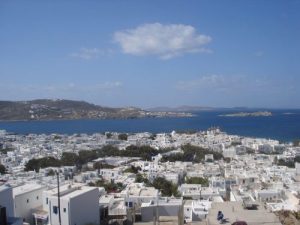 Once seriously stylish and exclusive, Mykonos Town has lost its edge of late. The chic bistros and designer bars are still here, but fewer clients top the celebrity charts.
Once seriously stylish and exclusive, Mykonos Town has lost its edge of late. The chic bistros and designer bars are still here, but fewer clients top the celebrity charts.
It still attracts a well-heeled clientele. It has to: meals cost double the average, drinks even more while menus are more Mexican, Thai or vegetarian than they are Greek.
Diners mostly gravitate to Little Venice, a clutch of tavernas perched over the sea where they ooze charm and squeeze wallets.
Other holidaymakers head for the main drag where cafe tables overlook the long quayside and where boys sashay past, pansied to perfection, before swanning off to a gaggle of gay clubs.
Unlike most island ports, Mykonos Town is not on a hillside but spread out over a plain. The harbour area is split between the fishing quay where small boats are beached on the sand, and the main ferry port where concrete frames the view.
Most traffic is banned from the waterfront and new building is confined to the outskirts so the centre invites exploration on foot and the chance to get lost in a maze of narrow streets.
Ano Mera
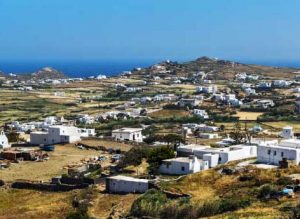 Ano Mera is the only village of the island and is the antithesis of the cosmopolitan and bustling town of Mykonos.
Ano Mera is the only village of the island and is the antithesis of the cosmopolitan and bustling town of Mykonos.
The village located 8 km from the capital of the island. You can find some good Greek taverns and restaurants as well as rooms for rent and several shops and supermarkets.
Panagia Tourliani is one of the major attractions of the village and the whole island with the Ecclesiastical Museum , where they have gathered relics from the 17th century , Vestments , images , scripts , etc. You can go there either by bus from th town or by scooter or car.
Agios Ioannis
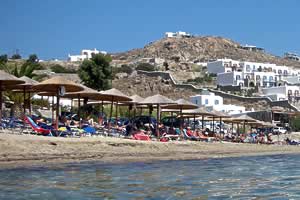
Agios Ioannis became famous from the english film Shirley Valentine that tells the story of a bored english housewife (Pauline Collins) that comes here looking for some adventure. There is a small beach with a small marina near by the church of Agios Ioannis.
At the beach there are some hotels among them the hotel Manoulas where the above film was shut.
Agios Ioannis beach is rather small, with sand and pebble, but it is located in a very picturesque bay and there are lots of small coves to enjoy along this part of the coast.
Although close to Mykonos Town, just five kilometers away, Agios Ioannis has less to offer than nearby beaches like Ornos and so tends not to attract the large crowds.
Ornos
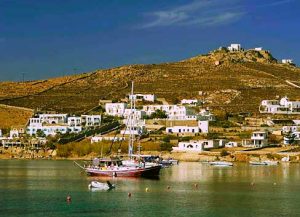 Ornos village located less than two miles south of the town of Mykonos, Ornos is a lovely area and is very popular among families. Ornos beach is considered by many as the best beach in Mykonos and is well organized.
Ornos village located less than two miles south of the town of Mykonos, Ornos is a lovely area and is very popular among families. Ornos beach is considered by many as the best beach in Mykonos and is well organized.
The second beach in this area is Korfos, it is not very popular because of the position exposed to northerly winds and its proximity to the island’s desalination plants.
The area is relatively calm, despite having an excellent tourist infrastructure and a public bus with good connections to the city of Mykonos.
In the village you will find a supermarket, a fruit and vegetable market, a bakery, a pharmacy, a kiosk with international newspapers and a good number of taverns, restaurants and bars of excellent qualit
Platys Yialos
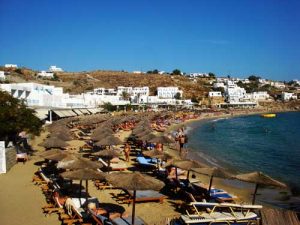 Platys Yialos is one of the most touristy resorts in Mykonos noted for some its many beach tavernas, soft sand, shallow water and as one of the main staging posts for water taxis along the south coast.
Platys Yialos is one of the most touristy resorts in Mykonos noted for some its many beach tavernas, soft sand, shallow water and as one of the main staging posts for water taxis along the south coast.
Just four kilometres from Mykonos Town, the bus stops close to the beach above some steep wooden steps and near some shops. Services run every 30 minutes through the summer season.
A small jetty provides moorings for the daily water taxis that shuttle holidaymakers to the various south coast beaches.
The back of the beach is an almost continuous line of tavernas offering a wide variety of food. Visitors praise the good food on offer at reasonable prices and enjoy the waiter service from the sun loungers.
What to see
The windmills of Mykonos
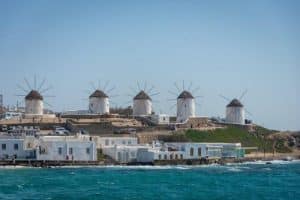
The island’s strategic location on a major sea trade route from Venice to Egypt and the need to refine grain for the ships en-route coupled with year-round winds made Mykonos the perfect location.
There were once more than 20 on the island but only seven remain today and they continue to be a great tourist attraction.Today’s windmills at Kato Myloi are located south-west of Mykonos Town between the picturesque Alefkadra and Niohori areas of the town.
They are well preserved and well-kept, standing in a neat row overlooking the harbour and the sea. They are one of the most distinctive sights, not only of Mykonos but of the Cyclades islands in general and their trademark picture is known all over the globe.
The churche of Paraportiani
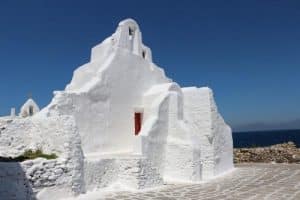
There are more than 70 churches on the island of Mykonos but the church in Paraportiani the best known and, like the windmills, has become a trademark of both Mykonos island and the Greek islands in general.
It is found at the entrance to the central harbour and is actually five small churches in one, four at ground level and the fifth built on the roofs of the others.
More sculptural than architectural, the resultant building has an organic whole that defies its separate parts.
The name ‘paraportiani’ means ‘inner door’ and the church was once a doorway set in the medieval stone wall that once circled the area. Building on the first church began in 1475 and the others were added over time with the last completed in the 17th century.
What to do
 While the all night revellers are sleeping off their excesses and the remaining masses are down at the beach, seize your chance to explore Mykonos Town (officially Hora) which is one of the most beautiful towns in the Cyclades. The town is relatively uncrowded during the day, even in high season, so you can stroll at leisure through its charming maze of white alleyways getting hopelessly lost but uncovering new delights at every turn.
While the all night revellers are sleeping off their excesses and the remaining masses are down at the beach, seize your chance to explore Mykonos Town (officially Hora) which is one of the most beautiful towns in the Cyclades. The town is relatively uncrowded during the day, even in high season, so you can stroll at leisure through its charming maze of white alleyways getting hopelessly lost but uncovering new delights at every turn.
There are plenty of shady tavernas where you take some refreshment and rest your feet after wandering the bewildering lanes which were originally designed to baffle the pirates who once plagued these islands.
If you’re interested in the island’s history and culture there’s a good variety of museums to visit. The Archaeological Museum has a wide range of exhibits including treasures unearthed on the nearby island of Delos which is one of the most important archeological sites in Greece. Highlights include a collection of ceramics from the 6th and 7th centuries BC, a statue of Heracles and a Minoan storage jar. The exhibits are housed in a neoclassical building just south of the ferry port.
The Folk Museum is one of the best of its kind in Greece. It’s housed in an elegant 18th century mansion, built on part of the ancient castle wall near the Delos quay. The museum has a collection of ceramics, embroidery and ancient Mykonian textiles.
You can also see the original Petros the Pelican who was the island’s mascot for 29 years – he’s now dead and stuffed and his replacement can be spotted fishing down by the quayside. One of the famous Mykonos windmills has been restored to full working order and is part of the museum.
The Aegean Maritime Museum in the centre of town has a fine collection of model ships, nautical instruments and coins from the 5th century BC. Next door to it you’ll find Lena’s House which gives you a fascinating glimpse into the life of a 19th century Mykonian lady. Everything has been perfectly preserved, from the furnishings down to the smallest items including Lena’s chamber pot and needlework.
Visit the Municipal Art Gallery on Matogiani in the town centre to view work by local and international artists.
In the Kastro, near Little Venice, you’ll find the island’s most famous and beautiful church – Panagia Paraportiani which is an extraordinary building, part of which dates back to 1425.
Take a boat trip over to the uninhabited island of Delos, the mythical birthplace of the twins Apollo and Artemis and now a giant open air museum. Wear sturdy shoes and if you’re feeling energetic climb the 113 metres to the top of Mount Kythnos for wonderful views of Delos and the surrounding islands.
For a complete contrast to Mykonos Town, take a trip over to the unspoilt inland village of Ano Mera, 7.5 kilometres to the east. The main attraction is the 16th century monastery of Panayia Tourliani in the central square where you can see a collection of Cretan icons and an unusual 18th century marble baptism.
Eating out
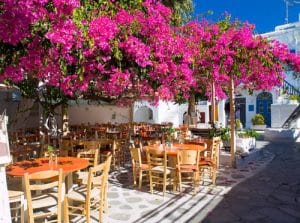
Ereyone owes it to themselves to visit the island of Mykonos at least once in their life.
Undoubtedly, Mykonos is a special island that fascinates its visitors. Undoubtedly, Mykonos is a special island that fascinates its visitors.
On the culinary map of Mykonos every year there is some great arrival, which renews the interest of foodies worldwide and maintains the reputation of the island at high levels.
Local cuisine
One of the most traditional dishes of Mykonos that you must try is the pig’s head in pieces with cabbage. Also, the traditional onion pie and the eggplant pilaf should definitely be on your list.
Try the local sharp cheese (kopanisti) that has been officially recognized as a product of designation of origin and is found on every island of the Cyclades. It is mainly known in Andros, Tinos and Mykonos and don’t forget to try the local sour cheese.
You must also give Mykonos’ sausages a chance, and of course you won’t miss trying candies with honey and grated almonds.
Shopping
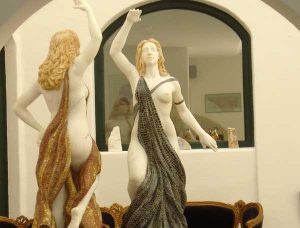 Souvenir and folklore shops can be found everywhere in Mykonos, ceramics of Cycladic Art, small statuettes, T-shirts, sunbathing clothes etc. But since Mykonos has as well its celebrity clientele you will find extreme expensive boutiques with men and women fashion made by iternational brands. Some of the famous Greek desighners have their summer fashion shops in Mykonos and no one can resist the charm of the window shopping. Or to put it another way, no one can be tempted to fantasize about wearing all the stylish treasures he sees in every alley.
Souvenir and folklore shops can be found everywhere in Mykonos, ceramics of Cycladic Art, small statuettes, T-shirts, sunbathing clothes etc. But since Mykonos has as well its celebrity clientele you will find extreme expensive boutiques with men and women fashion made by iternational brands. Some of the famous Greek desighners have their summer fashion shops in Mykonos and no one can resist the charm of the window shopping. Or to put it another way, no one can be tempted to fantasize about wearing all the stylish treasures he sees in every alley.
Most of the shopping is along Matogianni Street where you will find many boutiques, light jewelry, and tourist items, on the west side of the town behind Alefkandra you will also find many linen shops and jewelry stores. Branches of the most famous Greek jewelry stores can be found in Mykonos such as Ilias Lalaounis opposite the fasion gallery Galatis.
If you are interested in something more traditional on Zouganeli Street, you can buy sweets and local delicacies from macaroons at the Efthymiou store. Another interesting store of beauty products that is all made from Greek oil, is oliv oil, which is also located on the same street.
Some of the local products of Mykonos, such as Kopanisti cheese can be found at the “Lykos” food store on Matogianni Street. In Taverna Psistaria Spilia next to the Primary School you can buy local cheese and cold cuts as well as syglino of Mykonos. In Mykonos you will also find many banks with 24 hour banking ATMs, mobile phone shops, supermarkets, newspapers and kiosks.
Beaches
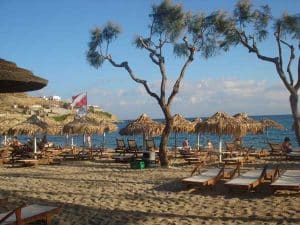
However, this does not mean that this splendid Greek island also offers more quiet and authentic beaches, where you can discover contact with nature and local folklore.
The large peninsula to the south west of Mykonos town has many attractive coves but the area’s main beaches are fairly undistinguished. The heavy tourist hotel development has left its mark and few can be said to be scenic. The proximity to the capital, rather than intrinsic merit, has encouraged the hotel developers and marketers to promote them as fully fledged beach.
Where to stay
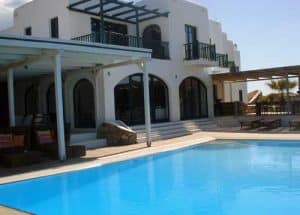
The island’s excellent bus service means visitors can void the pricey town and pick up plenty of cheaper rooms elsewhere.
Holiday ferry arrivals will probably have to run a gauntlet of offers from islanders touting offers of rooms at the port or they can check out prices at the travel agent rooms nearby. Many head for the Mykonos Accommodation Centre, found near Tria Pigadia, which posts vacancies.
Visitors looking to savour the island night life will prefer to stay in or around the Chora, but don’t expect to find anywhere cheap in the high season. Most other island accommodation is focussed on beach resorts along the south coast while those on a budget can book in at the campsites at Paranga and Paradise beaches.
Nightlife and clubbing
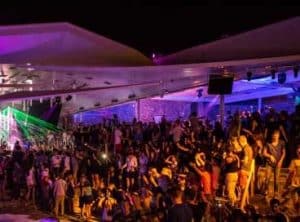
From the bars in the much-photographed Chora to the strong beach life on some of the most beautiful beaches of the Cyclades and from the after-hours parties with first-class DJs to over-the-top clubs in luxury hotels, gourmet restaurants, but also the more relaxed phases on the beaches and hangouts of the insiders.
Mykonos is an island that is constantly kept at the forefront, renewing its travel product and strongly betting on inbound tourism.
When to go
The weather on Mykonos is typically Mediterranean with long, hot and sunny summers following the mild, wet winters. Spring has temperatures in May rising to 20°C while June and July offer heatwaves in the high 20s with August thermometers averaging 27°C and topping 35°C on some days.
Mykonos is a windy island. Strong southerly winds in spring are replaced by the northerly meltemi in the summer. Holiday visitors will be unlucky indeed to see any rain at all over the summer holiday months and the mercury will often hit 30°C.
Autumn temperatures drop to a warm sub 20°C but days should stay dry. Winter has lows of 12°C and Mykonos gets most of its rain between January and March.
Getting around Mykonos
Car Hire
Mykonos roads are reasonably good between the resorts, especially in the south which is where the main tourist beaches are found. Roads in the north tend to be less good.
There are plenty of car and bike rental shops, most of them can be found just south of the Fabrika Square bus station.
If you must park in Mykonos Town don’t do so in a no-parking area – the police remove the number plates and demand a hefty fine before handing it back.
Buses
The bus service on Mykonos is provided by KTEL which has a fleet of 26 buses and is considered one of the best in the Greek islands. Buses run frequently and are usually on schedule. There are two bus stations on Mykonos island.
The North bus station is located near the Archaeological Museum and provides regular services to Ano Mera, Elia, and Kalafatis beaches.
The south bus station located next to the Olympic Airways office in Fabrika Square and has regular daily services to beaches at Platis Yialos, Psarou, Ornos, Paradise and to Paraga.
A bus leaves the olfd port for the north-west coast resorts of Agios Stefanos and the new port. You can find more English language details on the Mykonos KTEL site here KTEL Mykonos or telephone 023360 or 026797
Taxi service
There are many taxis in Mykonos, it sounds a lot but there can be 70,000 plus tourists on Mykonos in the summer so finding a taxi can sometimes be a problem. The main taxi rank is in Mavros Square, near the statue of Manto Mavrogenenous and taxis are in great demand at busy times when the queues can be very long. Mykonos taxis do not have meters but a notice board displays fares to all the popular beaches. There are also radio taxis available on 022400.
Cart-towing scooters
As well as the normal car taxis there are cart-towing scooters, usually found around the port, that will take you and your luggage to your hotel – not a bad option as many of the streets are much too narrow to take a car, the streets have no names and the buildings have no numbers. Finding a hotel on your own can be a challenge.
How to get there
By air
Charter flights land at Mykonos International (JMK), four kilometres from Mykonos Town alongside daily domestic flights from Athens.
There are also flights to Crete (Heraklion), Rhodes, Santorini and Thessaloniki.
There is a regular bus service between the airport and ferry port town and a taxi rank opposite the terminal building. Outside is a large car park with short and long-term parking spaces.
By ferry
mykonos-by-ferryFerries run daily from the Athens’ port of Piraeus and from Rafina on the mainland. Cat ferries from Rafina also dock atn at the islands of Andros, Tinos and Syros and there are daily hydrofoil and fast catamaran services to other Greek islands, not only in the local Cyclades, but also to Crete And Rhodes in the south and to Samos and Lesvos in the north.
Taxi boats take bather to beaches along the south coast throughout the summer. They leave daily from Platis Gialos and Ornos while excursion boats offer many day trips to Delos island.
Usefull Telephones
Mykonos from abroad: 0030 2280 + Number
Island code: 2289
Airport: 022327
Buses: 023360
Medical: 023998
Police:
Port: 022218
Taxis: 023700, 022400
Tourist Office:
Tourist Police: 022482
